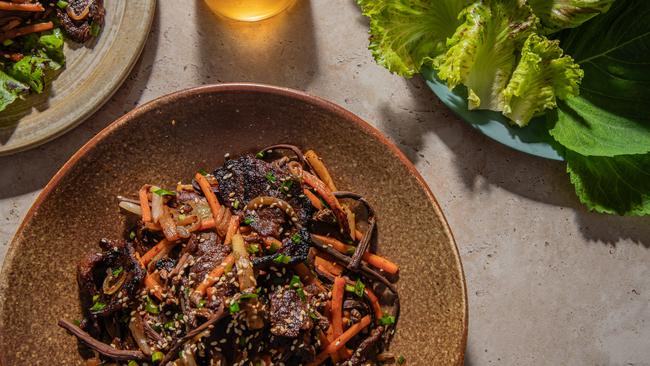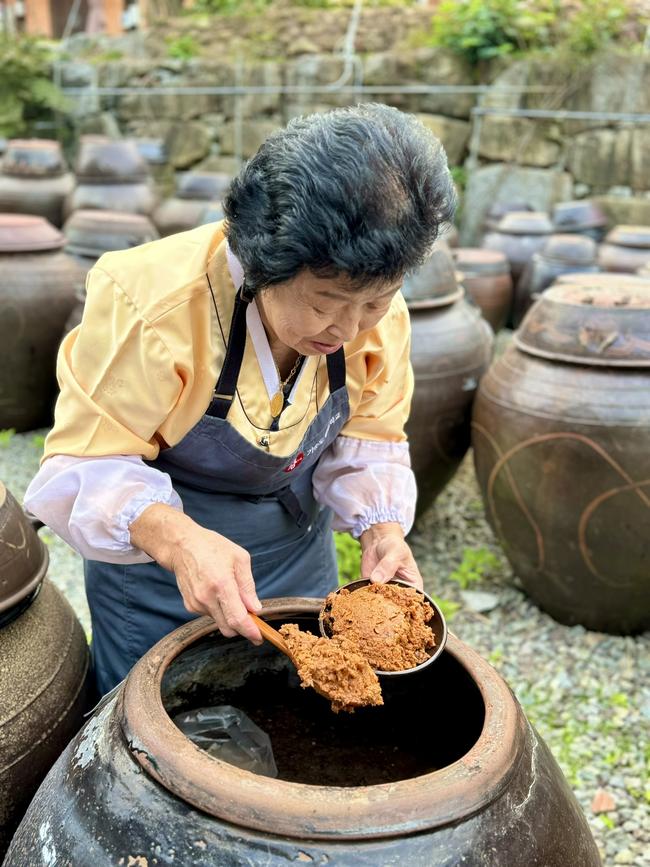The tradition behind these dishes spans centuries
The meatis tender enough to cut with a chopstick, its edges slightly charred, the interior soft and juicy.

There’s a hushed reverence that settles over you on arrival at Kisoondo’s estate, nestled among the misty forests and terraced fields of South Korea’s Damyang County. A wisp of smoke hangs low over the valley, from the wood-fired kilns that are still used to make the local bamboo charcoal salt. Row upon row of onggi pots, each one a vessel of history and patience, stretch out like sentinels under the Korean sun.
Weathered and timeworn, each earthenware pot contains a type of jang or Korean fermented soybean-based condiment such as soy sauce (ganjang), soybean paste (doenjang) and red chilli paste (gochujang). Kisoondo is a true artisan celebrated for her mastery of traditional fermentation techniques, continuing the work of her family over the past 370 years. The jars seem to hum with life, their lids barely restraining the alchemy within.
The fermenting soy sauce, nurtured by Kisoondo’s meticulous care, captures the passage of time, transforming the humble soybeans and brine into a liquid so deep and complex it feels sacred. Kisoondo moves monastically among the pots, as if in communion with them. There’s reverence in her gestures, whether examining a jar or recounting her family’s legacy.
After she has shown us how to make our own soy sauce, she invites us in for a lesson in Korean cooking. Among the many dishes we make is bulgogi, a beloved barbecue dish that translates to “fire meat”, featuring thinly sliced pieces of hanwoo, Korea’s answer to wagyu.
The meat is steeped in a delicious marinade that’s equal parts sweet and savoury – a heady concoction of soy sauce, gochujang, sesame, onion, garlic, ginger, sugar, and fresh pear juice, which tenderises the meat fibres. Kisoondo works quickly, her hands moving with the ease of someone who has made this dish for decades. When we eat, the dishes aren’t served so much as presented. The bulgogi is tender enough to cut with a chopstick, its edges slightly charred, the interior soft and juicy. Fresh perilla and lettuce leaves allow the sweet, savoury and spicy flavours to shine through.
Kisoondo smiles as we eat, taking immense joy from our appreciation of not only the food but of the craft she has preserved and shared. In the end I am filled with more than just flavours; I carry the memory of a woman who cooks with an unyielding respect for nature, tradition, connection, and life itself.
Try too my Korean shallot pancakes.


Bulgogi
Ingredients
- 600g beef (such as chuck tail, rump cap or sirloin), thinly sliced
- 1 medium daikon or white radish (approximately 300g), julienned
- 1 carrot, julienned
- 2 white onions, finely sliced
- 120g bracken (if available) or shiitake mushrooms (see note)
- 1 handful garlic chives, cut into 3cm batons
- ½ nashi pear, juiced
- 3 tablespoons light soy sauce
- 2 tablespoons brown sugar
- 75g gochujang (Korean chilli paste)
- 2cm piece ginger, finely grated
- 2 cloves garlic, minced
- 2 tablespoons toasted sesame seeds
- 2 tablespoons sesame oil
- 20ml grapeseed oil
Method
- Place the beef in the freezer for 30 minutes to firm, making it easier to slice thinly against the grain. This will help create tender slices with a wider surface area which will absorb the marinade and the flavours from the grill. In a bowl, mix the nashi pear juice, light soy sauce, brown sugar, gochujang, grated ginger and minced garlic. Stir well until the sugar dissolves and everything is combined.
- Add the thinly sliced beef to the marinade, ensuring all the pieces are well coated. Cover and refrigerate for at least 30-40 minutes (or up to 2 hours for a deeper flavour). Remove the beef from the marinade, which you can then use to coat the carrot, radish and onion. Fire up your grill or barbecue and grill the marinated beef in batches, ensuring each piece is nicely caramelised all over, removing to one side as you go.
- Heat a frying pan over a high heat. Add a small amount of grapeseed oil and add the marinated vegetables, cooking for 5-6 minutes until tender and lightly caramelised. Add the bracken or shiitake and continue to cook for a further 2-3 minutes. Add the grilled beef, sesame oil and garlic chives to the pan and toss with the vegetables. Sprinkle with toasted sesame seeds and serve the bulgogi warm, alongside steamed rice or as a filling for lettuce and perilla leaves.
Note: Steamed or preserved bracken, known as gosari, can be found all good Asian grocery stores and has a deep earthy flavour. Alternatively, use finely sliced shiitake mushrooms.
Serves 3-4

To join the conversation, please log in. Don't have an account? Register
Join the conversation, you are commenting as Logout